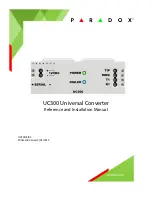
2
2.
TECHNICAL DATA
2.1.
SUPPORTED FILE FORMATS
Here is a list of all file formats that are supported by the UHD Player.
For additional information and tips on how to create content that works best with the UHD Player,
please see the
chapter.
2.1.1.
VIDEO
The UHD Player supports the following video formats:
Video Codec:
The video must be encoded as a h.265 (HEVC) or VP9 (webm) file with a
maximum resolution of 4096x2160@60p. h.264 that can be used up to
1920x1080@60p.
Resolution:
The maximum supported resolution is 3840x2160@60p or 4096x2160@60p
for h.265 or VP9 files and 1920x1080@60p using h.264 files.
Color Depth:
All video must be encoded at 4:2:0 chroma subsampling with 8 bits (Main
Profile) or 10 bits (Main 10 Profile) of color depth using h.265 codec and a
color depth of 8 bits using h.264 codec.
Frame Rate:
The maximum supported frame rate is 60 frames per second, and it is also
affected by your display hardware. We recommend using exactly the same or
an integral fraction of the frame rate that is shown on the display. So, if your
display has a refresh rate of 60 frames per second
,
it is recommended to
render the video with 30p or 60p.
Container Format:
The following container formats are supported: .mov, .mp4, .mkv, .webm
Bitrate:
A constant bit rate (CBR) of between 25 and 30 Mbps is recommended.
Playback Media:
All videos must be played from a Class 10 SD Card. If you are using a USB
drive or a USB stick
,
please ensure that the read capability is at least 30 MB/s.
Seamless Loop:
Seamless Loop function works for all supported container formats:
.mov, .mp4, .webm, .mkv
2.1.2.
IMAGES
The UHD Player supports the following image formats:
Image Format:
JPG, PNG.
Resolution:
The maximum resolution for still images is 8192x8192
pixels.
Color Depth:
The UHD Player supports
8 Bit color depth and a chroma subsampling of
4:4:4.
PLEASE NOTE:
Due to the capability of the Still Image Decoder, all images will be displayed with a maximum
resolution of 1920x1080px, regardless of their native resolution. To avoid this downsizing and to
take full advantage of your display’s resolution, you may create a video out of the images
by using
an external video editing software, e.g. ffmpeg (see







































